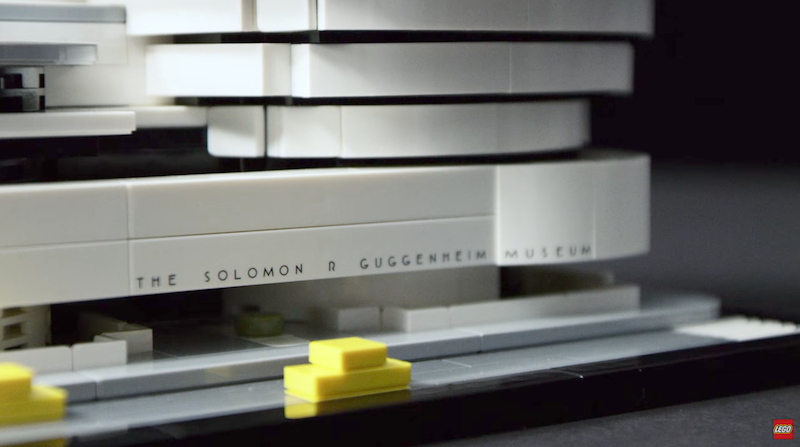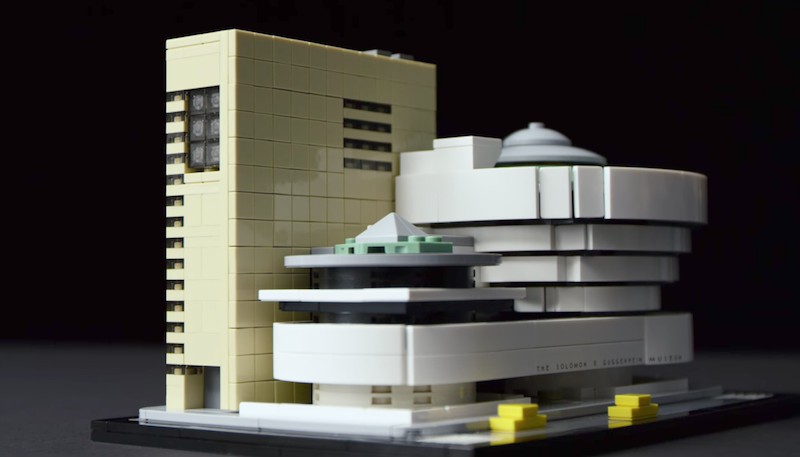Have you ever dreamed of (or possibly even lied about) designing a new addition to the Guggenheim Museum a la George Costanza? If you have, then LEGO Architecture’s newest model is for you. The Solomon R. Guggenheim Museum set provides the most realistic depiction of the landmark museum LEGO has ever offered, wrapped up in a 744 brick, $79.99 package.
This new set is an update of an earlier edition released in 2009, according to The Brothers Brick. The new version adds some true-to-life color, such as the sand green details on the rotunda, is much larger (744 pieces compared to 208 pieces), and is much more accurate in its depiction; air conditioning units are on top of the office building addition and the elevator shaft can be found at the rear of the museum. The details of this model extend to the street, where there are two yellow taxis and two crosswalks.
 Courtesy of LEGO.
Courtesy of LEGO.
The model comes with an instruction booklet that includes pictures and information about Frank Lloyd Wright and the real Guggenheim Museum. For more information on the model, watch the video below.
Related Stories
BIM and Information Technology | May 26, 2015
Lego-like model building kit was created by an architect for architects
Arckit, as the system is called, was designed to a 1:48 scale, making it easy to create models accurate to the real-life, physical building projected.
BIM and Information Technology | May 26, 2015
Moore's Law and the future of urban design
SmithGroupJJR's Stephen Conschafter, urban designer and planner, discusses his thoughts on the 50th anniversary of Moore's Law and how technology is transforming urban design.
Architects | May 26, 2015
AIA design competition creates portable, temporary housing for the homeless
The winning design from the AIA's "A Safe Place" competition was built at the AIA convention in Atlanta and later donated to a local non-profit partner.
BIM and Information Technology | May 21, 2015
How AEC firms should approach BIM training
CASE Founding Partner Steve Sanderson talks about the current state of software training in the AEC industry and common pitfalls in AEC training.
Architects | May 20, 2015
Architecture billings remain stuck in winter slowdown
Regional business conditions continue to thrive in the South and West
University Buildings | May 19, 2015
Special Report: How your firm can help struggling colleges and universities meet their building project goals
Building Teams that want to succeed in the higher education market have to help their clients find new funding sources, control costs, and provide the maximum value for every dollar.
University Buildings | May 19, 2015
Renovate or build new: How to resolve the eternal question
With capital budgets strained, renovation may be an increasingly attractive money-saving option for many college and universities.
University Buildings | May 19, 2015
KU Jayhawks take a gander at a P3 development
The P3 concept is getting a tryout at the University of Kansas, where state funding for construction has fallen from 20% of project costs to about 11% over the last 10 years.
Multifamily Housing | May 19, 2015
Zaha Hadid unveils 'interlocking lattice' design for luxury apartments in Monterrey, Mexico
Hadid's scheme was inspired by the Mexican tradition of interlocking lattice geometries.
Retail Centers | May 18, 2015
ULI forecast sees clear skies for real estate over next three years
With asset availability declining in several sectors, rents and transactions should rise.















